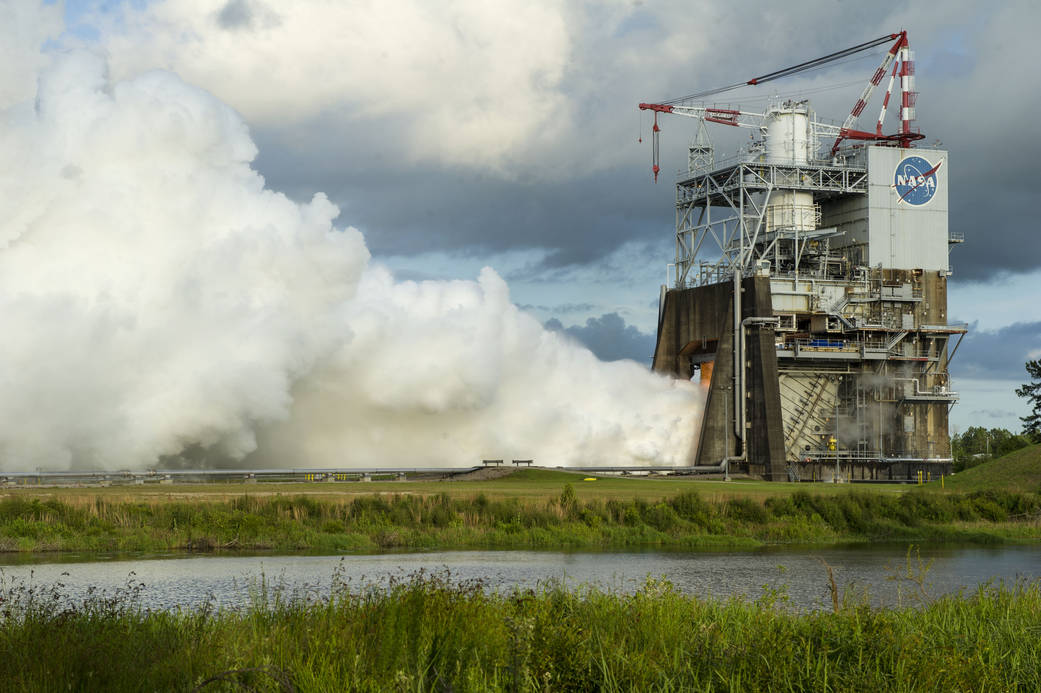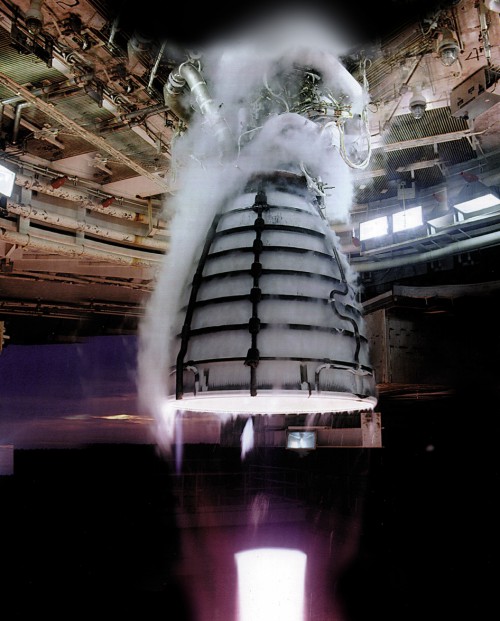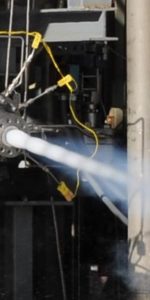
NASA’s Space Launch System (SLS) rocket is quickly manifesting into reality. Its solid rocket booster was test fired just a couple months ago, NASA’s Pegasus transport barge is being made larger to support moving the colossal rocket, acoustic sound-suppression testing is occurring, F-18 Hornet fighter jets are carrying out flight tests for SLS flight software development, test stands are being built or modified, KSC’s iconic Vehicle Assembly Building (VAB) is being upgraded to support SLS, launch pad 39B is being prepared, the rocket’s Mobile Launch Platform (MLP) and Crawler Transporter are being prepared, and both qualification and flight hardware for the first SLS vehicle itself are being constructed for an inaugural 2018 launch on the Exploration Mission-1 (EM-1) flight with NASA’s Orion deep-space multi-purpose crew capsule (which itself conducted its first flight test last December).
The latest happening on America’s “Journey to Mars” occurred yesterday (May 28, 2015), as the space agency conducted a second test fire of the RS-25 main engine that will help power the 320-foot-tall SLS off its launch pad 39B at Kennedy Space Center, where astronauts will ascend from to escape Earth’s orbit for destinations farther from home than any human in history has ever been.

The 450-second test fire, carried out by development engine #0525 on the historic A-1 test stand, went off without issue—something that has come to be expected of the RS-25 engine, which formerly powered NASA’s now-retired space shuttle fleet uphill on 135 missions. The RS-25 was the first reusable rocket engine in history, as well as being one of the most tested large rocket engines ever made, having conducted more than 3,000 starts and over one million seconds (nearly 280 hours) of total ground test and flight firing time over the course of NASA’s 30-year space shuttle program.
The engines proved their worth time and time again, but the RS-25 now requires several modifications to meet the giant rocket’s enormous thrust requirements.
Yesterday’s test fire will provide engineers with critical data on the engine’s new state-of-the-art controller unit—the “brain” of the engine, which allows communication between the vehicle and the engine itself, relaying commands to the engine and transmitting data back to the vehicle. The new controller also provides closed-loop management of the engine by regulating the thrust and fuel mixture ratio while monitoring the engine’s health and status, thanks to updated hardware and software configured to operate with the new SLS avionics architecture.
“We’ve made modifications to the RS-25 to meet SLS specifications and will analyze and test a variety of conditions during the hot fire series,” said Steve Wofford after the first test fire earlier this year, manager of the SLS Liquid Engines Office at NASA’s Marshall Space Flight Center in Huntsville, Ala., where the SLS Program is managed. “The engines for SLS will encounter colder liquid oxygen temperatures than shuttle; greater inlet pressure due to the taller core stage liquid oxygen tank and higher vehicle acceleration; and more nozzle heating due to the four-engine configuration and their position in-plane with the SLS booster exhaust nozzles.”
For shuttle flights the engines pushed 491,000 pounds vacuum thrust during launch—each—and shuttle required three to fly, but for SLS the power level was increased to 512,000 pounds vacuum thrust per engine, and the SLS will require four to help launch the massive rocket and its payloads with a 70-metric-ton (77-ton) lift capacity that the initial SLS configuration promises.
The pace for SLS engine testing at Stennis is expected to pick up this summer. After the first test fire on Jan. 9, upgrades were needed on the A-1 test stand’s high pressure industrial water system, which provides cool water for the test stand during a hot-fire engine run. Engine 0525 will carry out a total of seven test fires in this first series of tests and will fire for a grand total of 3,500 seconds, followed by another 10 test fires with another development engine, which will be put through its paces for a grand total of 4,500 seconds.
To put the power of the Aerojet Rocketdyne-built RS-25 engines into perspective, consider this:
- The fuel turbine on the RS-25’s high-pressure fuel turbopump is so powerful that if it were spinning an electrical generator instead of a pump, it could power 11 locomotives; 1,315 Toyota Prius cars; 1,231,519 iPads; lighting for 430 Major League baseball stadiums; or 9,844 miles of residential street lights—all the street lights in Chicago, Los Angeles, or New York City.
- Pressure within the RS-25 is equivalent to the pressure a submarine experiences three miles beneath the ocean.
- The four RS-25 engines on the SLS launch vehicle gobble propellant at the rate of 1,500 gallons per second. That’s enough to drain an average family-sized swimming pool in 60 seconds.
The next RS-25 test fire is currently scheduled to take place sometime between June 10-12.
VIDEO: SLS RS-25 engine test fire #2 at Stennis Space Center May 28, 2015 (credit NASA)
Four previously-flown RS-25 engines will be attached to the first SLS core stage, which will be manufactured at Michoud Assembly Facility in New Orleans, and test fired together atop the B-2 test stand at Stennis as a stage before being approved for the first SLS launch, planned for late 2018.
NASA currently has 16 RS-25 engines in their SLS inventory, 14 of which are veterans of numerous space shuttle missions. Aerojet Rocketdyne just recently finished assembly of the sixteenth engine, engine 2063, one of the space agency’s two “rookie” RS-25’s. It will be one of four RS-25 engines that will be employed to power the SLS Exploration Mission-2 (EM-2), the second SLS launch currently targeted for the year 2021.
“There is nothing in the world that compares to this engine,” said Jim Paulsen, vice president of Program Execution Advanced Space & Launch Programs Aerojet Rocketdyne. “It is great that we are able to adapt this advanced engine for what will be the world’s most powerful rocket to usher in a new space age.”
The SLS program also kicked off its Critical Design Review (CDR) earlier this month at NASA’s Marshall Space Flight Center in Huntsville, Ala., which demonstrates that the SLS design meets all system requirements with acceptable risk and accomplishes that within cost and schedule constraints. The CDR proves that the rocket should continue with full-scale production, assembly, integration, and testing, and that the program is ready to begin the next major review covering design certification. The SLS CDR is expected to be completed by late-July.
However, a late 2018 inaugural SLS launch is becoming more and more questionable, as politics and budgets always seem to hinder progress. Congress is seeking significant shift in NASA’s budget priorities, and NASA Administrator Charles Bolden had the following to say about it:
“Unfortunately, this work is in jeopardy of being halted, delayed or possibly undone by the [House Appropriation Committee] Budget Bill as currently written.”
Time will tell …
Be sure to “Like” AmericaSpace on Facebook and follow us on Twitter: @AmericaSpace





Thanks for the report and great images.
So exciting to see the mighty Ares V (aka SLS) coming to fruition.
I’m guardedly optimistic about the push to transition the “make work” ARM mission to Ph-D (aka Phobos mission).
Important next step: when the time comes, a grassroots campaign to push the next administration to move Dava Newman to the Administrator post (assuming she has the stomach for the politics, maybe by then she won’t).
It is probably a mental hiccup that causes me to think about the old engines that Orbital was using when reading this article about used engines.
The engines Orbital was using dated back to the 1960’s (literally the engines themselves not just the design).
No argument here. Just a comment on the thoughts I had, regardless of reality.
The RS-68A and the 5 segment SRB are the most powerful engines of their type. I was disappointed with the choice of the RS-25 though they do have a higher Isp than the RS-68A. But the fact that the RS-68A is designed to be cheaper and is more powerful makes me wonder why they could not use them. It would seem redesigning the configuration to use these two types would have been the smart thing to do. Going cheap always ends up costing more in the end. What is needed for space exploration is a launch vehicle much larger than the Saturn V mounting four 5 segment SRB’s and maybe five RS-68A’s for over 17 million pounds of thrust. This vehicle launching an upper stage wet workshop every two months would be far more useful for creating a cislunar infrastructure.
>RS-68A…cheaper…more powerful makes me wonder why they could not use them. It would seem redesigning the configuration to use these two types
If you look closely at the embiggened image of the RS-25 (above), you can see that the exhaust nozzle & plumbing are coated with frost, and there is water dripping down around the bottom edge before it’s flashed into steam by the blazing hot exhaust. How can that be? It’s because the RS-25 (aka SSME) has a regeneratively cooled nozzle which circulates cryogenic liquid Hydrogen through manifolds connected to hundreds of tubes making up the nozzle itself. This was done because the SSME engine is a: reusable b: the nozzle “sees” the infrared flux from the white hot SRB exhaust.
The RS-68 was not designed to deal with either issue. The RS-68 uses an ablative coating inside its simple, single use exhaust nozzle. And of course, the Delta IV, for which the RS-68 was specifically designed, has no SRBs.
All this means: the RS-68 and RS-25 are radically different designs meant for different vehicle families, and they are not interchangeable.
This is real basic stuff.
What is real basic stuff is that regenerative cooling and SRB’s have nothing to do with precluding interchangeability. Puh-leez.
The article mentions this in particular. The engines, being in plane with the SRBs, will experience much higher heating rates. Ablative cooling is on the inside of the nozzle, and therefore will not help with the external heat flux. Whether or not this is a show stopper I don’t know.
There is an additional issue of what I guess you could call “plumb footprint” the RS-68’s were not designed to be used so close to each other.
They were considered for use on the Ares V and were eventually eliminated (in favor of the RS-25E’s) for that and other reasons.
Yes, a redesign using a larger diameter stage would have fixed it.
Redesign of a larger diameter stage would have also required redesign and rebuilding of considerable portions of the ground handling equipment.
That costs a lot of money.
Was not in the budget then, is not in the budget now.
It is fun (for all of us) to dream about what we would like to do given unlimited resources, but when actually working on something you have to deal with the resources you are actually given.
I wouldn’t suggest trying to change them now. In the original design though, RS68 pumps and combustion chambers ganged to an aerospike would seem to be a good trade. GG exhaust through the recirculation zone and ablation facing out toward the heat flux from the solids. Use cheaper engines in volume production.
Interesting concept, but reference to the post above:
That costs a lot of money.
Was not in the budget then, is not in the budget now.
It is fun (for all of us) to dream about what we would like to do given unlimited resources, but when actually working on something you have to deal with the resources you are actually given.
I would have used standard four segment boosters with the development money for the fives diverted. Historical woulda coulda of course.
The Delta IV medium uses SRB’s- up to 4 small ones and with modifications more have been proposed being mounted. I think a SLS redesign would have been better in the long run.
Getting redundant, but one more time:
That costs a lot of money.
Was not in the budget then, is not in the budget now.
It is fun (for all of us) to dream about what we would like to do given unlimited resources, but when actually working on something you have to deal with the resources you are actually given.
Yes, the RS-68A being existing technology- a resource. I am quite familiar with the old “not in the budget” stick having been beat over the head with it for years by NewSpace fans. Having kept track of hundreds of billions of dollars in cancelled or worthless DOD projects over the years…..people screaming at the top of their lungs about spending money on building rockets as “wasting money” and “pork” simply disgusts me. Especially when it is really about them pushing their own libertarian space tourism agenda.
Great.
Tell you what, when you become the leader of the country and have the power cut the DOD Budget by the “hundreds of billions of dollars in cancelled or worthless DOD projects…” that you have identified and give it all to NASA.
I am sure they will be happy to receive it.
Until then, the people working on the projects will continue to have to try to work within the budgets they actually have.
Nonsense. The “leader of the country” does not “have the power” to “cut the DOD budget.” This is America. Some people just cannot stand it when someone states the obvious.
First you say:
“Having kept track of hundreds of billions of dollars in cancelled or worthless DOD projects over the years…..people screaming at the top of their lungs about spending money on building rockets as “wasting money” and “pork” simply disgusts me.”
Then you say:
“The “leader of the country” does not “have the power” to “cut the DOD budget.” This is America. Some people just cannot stand it when someone states the obvious.”
So what is your point, that the situation is hopeless and nothing can be done about it?
Then you might, at least, stop complaining that you do not like the SLS design because the money has not been made available to address your preferred solution.
What is your practical path to getting the funding for the people trying their best to work the hardware money to do the job that you want them to do (not just where you would take the money from – New Space, DOD? – but how would you take it, since you say “The “leader of the country” does not “have the power” to “cut the DOD budget.””)
Unless you can answer that specific question, you are just making empty complaints with no positive input.
“-you are just making empty complaints with no positive input.”
Actually Joe, I am making comments- that is what this box I am typing in is for. I am expressing my views on a public forum.
YOU are the one complaining and tasking me with changing the world. The president does not snap his fingers and the defense industry redirects half a trillion dollars the next day. You can stop complaining about me now.
For anybody with nothing better to do than keep following this particular conversation:
– Mr. Church seems to work by the rule “he who posts last wins”.
– Based on that each time he replies again after this, if you have any interest in how I would reply simply reference my post at May 31, 2015 at 8:21 pm.
It will save time and boredom.
Gary shows his hate of NewSpacers on a thread that has nothing to do with them! Drink!
NewSpace trolls- the bed bugs of the internet
>regenerative cooling and SRB’s have nothing to do with precluding interchangeability
Yes, in this case is does. In general, rocket engines are tough on the *inside* where the action is, and relatively fragile on the outside.
The SSME was designed from the get-go to withstand the heat on the *outside* from the other SSMEs exhaust streams, and the adjacent Shuttle SRBs.
The RS-68s could not take heat of clustering under the Ares V (SLS) and the huge SRBs. Various work-arounds were proposed, but they wound up creating other problems.
Another big problem with clustering a bunch of RS-68s under a big stack, the RS-68 uses a fuel rich gas generator cycle, while the SSME is a staged-combustion engine. All that RS-68 plumbing and the gas generator exhausts make it difficult to cluster a bunch of RS-68s together, *and* all that hydrogen from the gas generators would gather in the recirculation zone at the base of the vehicle, thus creating additional over-temp and pressure problems, the impressive looking “great balls o fire” Delta IV flashover times a hundred.
But why do you care anyway? I thought you were all about a “big dumb booster” with pressure-fed liquids surrounded by a bunch of SRBs – or something – to put water encased, giant rotating habitats in GEO do do -what? Big dumb being the operative word in any case.
“Various work-arounds were proposed, but they wound up creating other problems.”
Yes, I knew this- and my comment was “It would seem redesigning the configuration to use these two types would have been the smart thing to do.”
“Big dumb being the operative word in any case.”
Perfect description of your replies.
The four well understood, reliable, and highly efficient SSMEs on the core of the SLS, and the two elongated and powerful SRBs, should be both affordable and useful. And the work on the international Orion spacecraft is also making nice progress.
However, we do need a Lunar Lander in someone’s budget.